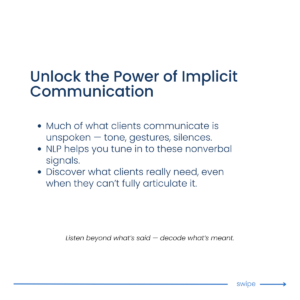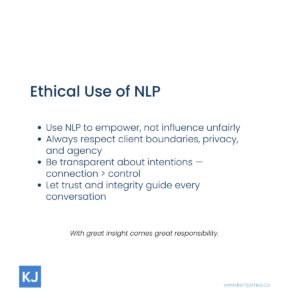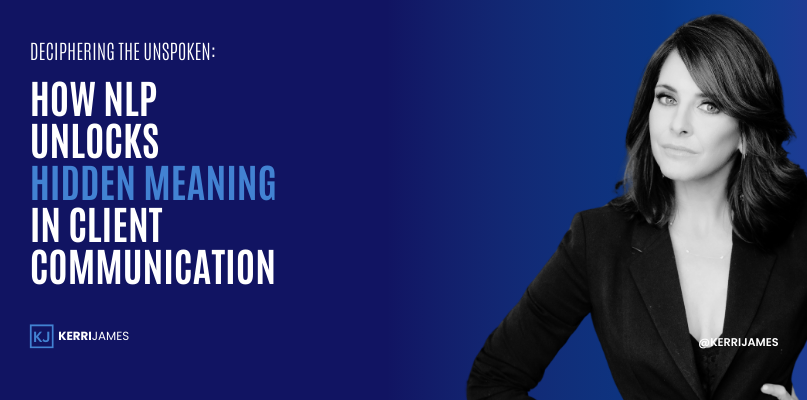Early in my legal career, I encountered a client who, despite verbally expressing agreement with our proposed strategy, seemed hesitant and uncertain. Their words said “yes,” but their body language hinted at a different story. This experience highlighted the crucial role of implicit communication—the unspoken messages conveyed through nonverbal cues, tone of voice, and subtle linguistic patterns. It led me to explore the power of Neuro-Linguistic Programming (NLP) in understanding these often-overlooked aspects of communication.
NLP offers a powerful framework for deciphering the unspoken messages that often lie beneath the surface of client interactions. It’s about recognizing that communication is much more than just the words we use. Body language, tone, facial expressions, and speech pauses reveal much about our thoughts and feelings. This isn’t about mind-reading or manipulation, but about listening, observing, and interpreting cues to build stronger client relationships and achieve better outcomes. Understanding implicit communication helps uncover hidden concerns, address anxieties, and deepen client connections.
The Importance of Implicit Communication in Client Interactions
In the legal profession, communication is often thought of as a clear, explicit exchange of information. Much of client communication is implicit—nonverbal cues or indirect expressions of emotions and concerns. Decoding these signals gives legal professionals deeper insight into client needs and motivations. By mastering implicit communication, lawyers can build stronger relationships, boost client satisfaction, and handle tough conversations with ease.
“Implicit communication includes subtle cues like body language, facial expressions, tone, and silence. In legal settings, where clients may feel overwhelmed or uncertain, these signals reveal emotions, fears, and concerns. Lawyers who understand these cues can build rapport, anticipate issues, and address concerns before they escalate.
 Identifying Unspoken Concerns and Objections
Identifying Unspoken Concerns and Objections
Clients often hesitate to voice their doubts, concerns, or objections directly—especially when they’re unsure, intimidated, or feel that their questions may seem trivial in the context of legal proceedings. As legal professionals, we must recognize that silence or vagueness in conversation does not necessarily mean agreement or satisfaction. Instead, it may indicate hidden concerns that need to be addressed. Implicit communication enables us to detect these unspoken issues, allowing us to respond more proactively and effectively.
For instance, a client who seems distant, avoids eye contact, or gives short, clipped responses might be harboring doubts about a proposed course of action. By recognizing these signs and addressing the issue directly—perhaps by saying, “I noticed you seemed uncertain when we discussed this last, is there something specific that’s worrying you?”—you create an opportunity for the client to express their concerns in a safe and non-judgmental space. This proactive approach not only alleviates potential misunderstandings but also strengthens the trust and rapport between you and the client.
Building Stronger Rapport and Trust
Implicit communication plays a crucial role in building and maintaining rapport with clients. By picking up on nonverbal cues, legal professionals can demonstrate empathy and understanding, even when no words are exchanged. This skill is particularly vital in establishing trust, which is the foundation of any successful attorney-client relationship.
For example, a client who appears uncomfortable with a certain aspect of the case or procedure may not explicitly express their discomfort. However, subtle signs such as nervous fidgeting, a tense posture, or a lack of eye contact can indicate that they are uneasy. Recognizing and addressing these cues—perhaps with a gentle inquiry like, “I see you’re holding your hands tightly. Is there something specific about this issue that’s causing concern?”—can make the client feel heard and validated. When clients feel that their unspoken emotions are acknowledged, they are more likely to trust you and your advice, knowing that you are attuned to their needs beyond the explicit conversation.
Navigating Difficult Conversations with Greater Ease
Legal proceedings often involve tough conversations, such as discussing unfavorable outcomes, negotiating settlements, or delivering bad news. In these situations, understanding implicit communication is particularly valuable. By noticing subtle shifts in body language or tone, lawyers can anticipate emotional reactions, de-escalate tension, and guide the conversation toward a more productive outcome.
For example, when discussing a difficult legal outcome with a client, the tone of their voice or their body language can provide immediate feedback about how they are processing the information. A client who becomes visibly tense or withdraws emotionally may need additional support and reassurance, which can be provided by acknowledging their emotions: “I can see this news is difficult for you, and I want you to know we’ll work together to find the best path forward.”
Additionally, implicit communication can help in managing the client’s emotions during these challenging conversations. A calm and measured tone of voice, paired with open body language, can reassure clients that they are in good hands, even in the face of adversity. Recognizing when a client is on the verge of frustration or confusion can allow you to adjust your approach, ask clarifying questions, and provide reassurance before the situation escalates.
Enhancing Negotiation and Persuasion Skills
Implicit communication is equally valuable in negotiation settings, where understanding the other party’s unspoken thoughts and motivations can offer a strategic advantage. In legal negotiations, clients may hesitate to vocalize their reservations or may not even fully understand their own concerns. Skilled legal professionals can use their knowledge of implicit cues to better understand the underlying motivations of all parties involved and adapt their approach accordingly.
For example, during a settlement negotiation, the opposing party’s subtle body language or tone might indicate their true position or readiness to compromise. If the opposing counsel avoids direct eye contact or fidgets during a certain discussion, this could suggest discomfort with a proposed settlement or a hidden reservation. By reading these cues, you can modify your strategy to push for more favorable terms or address concerns that may not have been expressed directly.
Likewise, within your own team, implicit communication can help legal professionals better coordinate their efforts, share insights, and align strategies. If a team member is subtly signaling frustration or confusion through their body language, it is essential to address it before it affects the overall negotiation process. Strong negotiation and persuasion skills are built on both verbal and nonverbal communication, with implicit communication acting as a key tool to gauge reactions, anticipate needs, and refine your approach.
Improving Client Satisfaction and Retention
Client satisfaction and retention are essential metrics for the success of any legal practice. Satisfied clients are more likely to return for future legal matters and recommend your services to others. One of the most effective ways to improve client satisfaction is by demonstrating a genuine understanding of their emotions and concerns, even when those concerns are not expressed explicitly.
When clients feel truly heard and understood on a nonverbal level, they experience a higher level of emotional satisfaction with the service provided. They feel that you are not only addressing their legal needs but also their emotional state, creating a more holistic and positive experience. This emotional connection builds trust and loyalty, which translates into repeat business and positive referrals.
For example, during a long, drawn-out legal process, clients may feel stressed, anxious, or overwhelmed, but they may not verbalize these feelings. However, nonverbal cues—such as a tense posture, rapid speech, or occasional sighs—can indicate that they are struggling. Recognizing these cues and offering reassurance, frequent updates, or a more personalized approach can enhance the client’s experience, increase satisfaction, and strengthen retention.
NLP Techniques for Decoding Implicit Communication
One of the most effective frameworks for understanding and applying implicit communication is Neuro-Linguistic Programming (NLP). NLP techniques focus on how language, behavior, and thought processes intersect, providing tools to decode implicit signals and improve client interactions. Below are some of the core NLP techniques for enhancing implicit communication in legal practice.
Sensory Acuity: Sharpening Your Observational Skills
Sensory acuity is a foundational skill in NLP that involves becoming highly attuned to a client’s nonverbal communication. By observing body language, facial expressions, tone of voice, and even breathing patterns, legal professionals can pick up on subtle cues that provide insights into a client’s emotional state. For instance, if a client avoids eye contact, fidgets, or speaks in a hesitant tone, these cues may signal anxiety or hesitation. Recognizing these signs allows you to address concerns proactively and create a more supportive environment.
Calibration: Establishing a Baseline and Recognizing Deviations
Calibration in NLP involves understanding a client’s typical behavior to spot changes in their emotional state. For example, if a usually talkative client becomes quiet, it may signal unease or a hidden objection. Recognizing this change in behavior allows you to probe further, ensuring that underlying concerns are addressed before they escalate.
 Representational Systems: Tailoring Communication for Enhanced Understanding
Representational Systems: Tailoring Communication for Enhanced Understanding
NLP theory suggests that people process information through different representational systems—visual, auditory, or kinesthetic. By identifying a client’s preferred system, legal professionals can tailor their communication style for greater clarity and rapport. For instance, a visual client might respond better to diagrams or charts, while an auditory client might appreciate detailed verbal explanations. Recognizing these preferences allows you to communicate in a way that resonates with the client’s cognitive processing style.
Meta-Model Questions: Uncovering Hidden Meanings
Meta-model questions are designed to help clients articulate their thoughts more precisely and uncover hidden meanings behind vague language. If a client says, ‘I’m not sure about this,’ ask, ‘What makes you unsure?’ or ‘What would boost your confidence?’ These questions clarify concerns and help clients express themselves more directly
Milton Model Language Patterns: Bypassing Resistance
The Milton Model in NLP uses intentionally vague language to bypass conscious resistance and tap into the unconscious mind. For example, instead of directly confronting a client’s fears, you might say, “I wonder what you’re feeling as you consider these options?” This indirect language invites the client to explore their concerns at a deeper level, without feeling pressured.
Practical Applications for Your Legal Team
- Client Intake: Use NLP techniques to quickly build rapport, identify underlying client concerns, and address potential objections early on.
- Negotiations: Apply implicit communication skills to understand the opposing party’s unspoken motivations and strategically adjust your approach.
- Mediation and Conflict Resolution: Decode implicit communication to address the emotional drivers of conflict and facilitate more effective resolution.
- Witness Interviews: Pay close attention to linguistic and nonverbal cues during witness statements to uncover inconsistencies or hidden truths.
NLP and implicit communication help legal professionals enhance client interactions, build stronger relationships, and achieve better outcomes.
Ethical Considerations in NLP for Client Interactions
Legal professionals must approach client interactions with integrity and respect, especially when using NLP to decode implicit communication. While NLP offers powerful tools for improving communication and understanding, it must be used ethically and responsibly. The goal of applying NLP in legal contexts should be to enhance the client experience and foster genuine rapport, not to manipulate or deceive.
One of the primary ethical considerations when using NLP is ensuring that you do not exploit the client’s vulnerabilities. NLP techniques, like reading body language and understanding emotions, should enhance communication and support, not serve the professional’s interests over the client’s. Manipulation, whether intentional or unintentional, violates trust and could undermine the attorney-client relationship.
Additionally, transparency is critical in all client interactions. Clients have the right to know which techniques are used and should feel safe, confident, and respected. NLP techniques should promote openness and give clients control over the communication process. Ethical use of NLP fosters an environment where the client’s concerns are addressed, and their autonomy is respected.
Moreover, it is important to acknowledge the boundaries of NLP in legal practice. NLP techniques improve communication but shouldn’t be used for psychological assessments. Legal professionals aren’t trained to diagnose or treat mental health issues, so any concerns should be referred to a qualified mental health professional. Offering psychological advice or overstepping the boundaries of one’s professional role can harm the client and the legal professional’s reputation.
Finally, when using NLP techniques, legal professionals should be cautious not to over-rely on them or place too much emphasis on reading between the lines. It is essential to remember that not all implicit communication is negative or indicative of a problem. Clients may simply have different communication styles or cultural backgrounds that influence how they express themselves. NLP should enhance communication, not impose a rigid interpretation of a client’s behavior or emotions.
Building Stronger Client Relationships Through Deeper Understanding
Effective communication is key in law, and decoding implicit cues can greatly improve client interactions. Using NLP techniques helps lawyers better understand client needs and emotions, strengthening the relationship.
One key benefit of using NLP in client interactions is building stronger, more empathetic relationships. Clients often feel vulnerable or stressed and may struggle to express concerns. By reading body language, tone, and subtle verbal cues, lawyers can address unspoken issues and offer deeper, more compassionate support.
A client may not voice anxiety but might show it through avoiding eye contact, crossed arms, or restlessness. By noticing these cues, a lawyer can ask thoughtful questions and encourage open, honest dialogue. This proactive approach helps the client feel seen and heard on a nonverbal level, which significantly builds trust and rapport.
When lawyers respond to both verbal and nonverbal cues, they build a more productive attorney-client relationship. This trust leads to open conversations on sensitive topics like case strategies and risks. Understanding implicit signals helps lawyers tailor their communication, improving the experience and reducing misunderstandings.
NLP techniques not only improve communication but also help legal professionals anticipate and meet clients’ needs before they voice them. By observing body language or recognizing subtle shifts in tone, lawyers can gauge when clients may be struggling with a decision, have reservations about a proposed solution, or need more information. Proactively addressing these potential concerns can prevent issues from festering or escalating into larger problems later in the legal process.
NLP helps lawyers build stronger client relationships beyond just one-on-one interactions. Legal teams can also apply NLP techniques to strengthen internal communication and collaboration. When team members understand the implicit cues of their colleagues—such as stress, frustration, or confusion—they can more effectively communicate and offer support. This improves team dynamics, promotes a positive workplace culture, and, ultimately, creates a better environment for client service.
How NLP Enhances Legal Outcomes
NLP improves legal outcomes by enhancing communication. It helps professionals understand clients’ explicit needs, as well as unspoken concerns, motivations, and emotions. This deeper insight leads to better decision-making, accurate risk assessments, and a more tailored legal strategy.
By recognizing a client’s anxiety, a lawyer can address concerns early, offering reassurance or more info to reduce uncertainty. Reading implicit cues during negotiations helps uncover unspoken motivations, giving lawyers a strategic edge. This leads to better settlements and more effective legal strategies.
Moreover, by improving the rapport between attorneys and clients, NLP helps build stronger, more lasting relationships. Clients who feel understood and supported are more likely to remain loyal to a firm, return for future legal matters, and refer others. This not only leads to increased client satisfaction but also boosts the firm’s reputation and client retention rates.
Practical Application of NLP in Legal Settings
Integrating NLP techniques into your legal practice requires a combination of skill, awareness, and empathy. Start by focusing on improving your sensory acuity—actively observing nonverbal cues such as body language, facial expressions, and tone of voice. This can help you pick up on subtle signals that reveal emotional states or unspoken concerns.
Calibration is another useful technique for establishing a baseline of client behavior. By observing how clients behave under normal circumstances and noting any changes in their behavior during significant conversations, you can identify emotional shifts or hidden reservations. Calibration helps create a more nuanced understanding of your client’s needs and emotional state.
Additionally, understanding representational systems—visual, auditory, or kinesthetic—enables you to tailor your communication style. For instance, visual clients might appreciate flowcharts or diagrams to explain legal concepts, while auditory clients may prefer verbal explanations. Kinesthetic clients, on the other hand, may respond best to more hands-on approaches or role-playing scenarios.
Meta-model questions and Milton Model patterns are powerful NLP tools for clarifying vague language and revealing hidden meanings. Meta-model questions prompt clearer client expression, while Milton patterns bypass resistance and tap into deeper emotional insights.
Using NLP within your team boosts collaboration, reduces misunderstandings, and improves efficiency. Active listening, reading nonverbal cues, and applying NLP techniques create a more supportive, harmonious work environment.
Final Words
In the legal profession, effective communication is the cornerstone of building strong client relationships and achieving successful outcomes. By mastering implicit communication and using NLP, legal professionals gain deeper insight into clients’ emotions, needs, and concerns. This builds trust and rapport. These skills help foster more open, honest, and productive conversations, allowing legal professionals to navigate difficult situations with greater ease.
However, it’s crucial to use NLP techniques ethically and responsibly. Use NLP to improve communication, not to manipulate or deceive clients. Transparency, respect for autonomy, and adherence to professional boundaries are essential to maintaining trust and integrity. Used ethically, NLP fosters client-centered relationships that drive better outcomes and greater success for legal professionals.
By reading implicit cues, legal professionals can deliver more personalized, empathetic service. This boosts client satisfaction and retention. Used properly, NLP enhances the client experience and raises the quality of legal practice.










